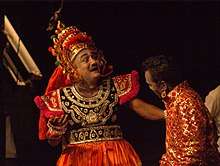Koothu
Koothu or Therukoothu (jwalith)(Tamil: கூத்து), is an ancient art, where artists play songs with dance and music in storytelling the epics, performed in Tamil; it is a folk art originated from the early Tamil country.[1][2] More precisely Koothu refers to either Terukuttu (Tamil:தெருக்கூத்து) or Kattaikkuttu. The terms Terukkuttu and Kattaikkuttu are often used interchangeably in modern times; however, historically, the two terms appear to have distinguished, at least in certain villages, between two different kinds of performance: while Terukkuttu referred to mobile performances in a procession, Kattaikkuttu denotes overnight, narrative performances at a fixed performance space. Koothu as a form of entertainment reached its peak hundreds of years ago in Tamil Nadu,[3] as mentioned in the Sangam texts about the development of iyal (literature), isai (music) and natagam (drama). Going beyond just a means of entertainment, koothu educates the rural people about religion and their history.[4]

| Koothu | |
|---|---|
| Stylistic origins | Ancient Tamil music, Dance forms of Tamil Nadu |
| Cultural origins | 200 BCE - 200 CE Ancient Tamil country |
| Typical instruments | Miruthangam - Cymbal - Vocal |
Koothu is an informal dance structure, in which performances generally depict scenes from ancient epics such as Ramayana, Mahabharata and Tamil classical epics. There is traditionally no spoken dialogue, only songs. Artists are trained to sing in their own voice and in a high pitch to reach the entire crowd, since no amplification technology is used. The artists are dressed up with complex heavy costumes and have a very bright elaborated makeup. They put on towering head dresses, sparkling shoulder plates and wide colorful skirts. Traditionally, this theatre form has been predominantly male, though in modern times more females have been included (for example Girl's Theatre at the Kattaikkuttu Gurukulam).
Types of koothu[5] include Nattu Koothu, Kuravai Koothu, and Valli Koorhu, which are about the state and culture of different peoples in Tamil country; Samaya Koothu showcases religious topics, while Porkaala Koothu, Pei Koothu, and Thunangai Koothu are focused on the martial arts and war of the country. Another important art form Chakyar Koothu, is very popular in Kerala. There is mention of this koothu in Silappatikaram.

In the past years, there were no formal training institutions, schools or nattuvanar (teacher) for koothu. Now, to encourage the dying art, there are some workshops for koothu called koothu pattarai, and also some dedicated schools (efor example Kattaikkuttu Gurukulam).
Koothu eventually spread from Tamil Nadu into most of South India, particularly Karnataka and Kerala. It is very popular in rural areas and has remained relatively unchanged even in modern times.
The deity at the Thillai Nataraja Temple, Chidambaram is known from the Sangam period as "Thillai Koothan", the cosmic dancer of Thillai; the Sanskrit translation of this is Nataraja.
Outside India
As Tamils migrated abroad to different areas such as Mauritius, Réunion, Guyana, Malaya, South Africa, Fiji, Mauritius, Trinidad and Tobago, Guyana, Suriname, Jamaica, French Guiana, Guadeloupe, and Martinique, they took this kuthu dance form to their new settlements, thereby promoting its growth universally.
In Fiji, Therukootu is also known as Tirikutu.
References
- Dance forms of Tamilnadu Archived 2015-08-14 at the Wayback Machine
- Tamilnadu.com Archived 19 June 2013 at the Wayback Machine
- Madurai Messenger - Times of Madurai - April 2010 : Therukoothu: The People’s Art
- "Therukoothu". Tamilnadu.com. 16 February 2013. Archived from the original on 19 June 2013.
- Theru Koothu Archived 2011-06-22 at the Wayback Machine
- Bhargava, Gopal K.; Shankarlal C. Bhatt (2006). Land and people of Indian states and union territories. 25. Tamil Nadu. Delhi: Kalpaz Publications. ISBN 81-7835-381-4.
External links
- Therukoothu.org
- TheruKoothu documentary, Bay of Bengal Programme Inter-Governmental Organisation
- Thenmodi koothu: https://kalaikurusil.com/